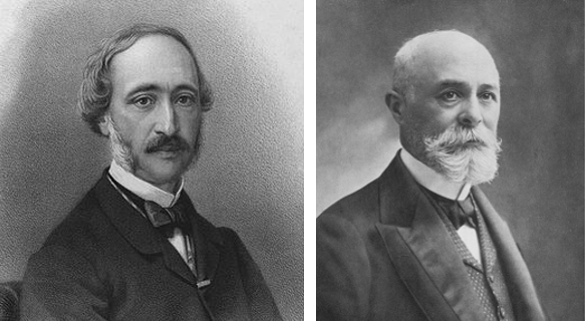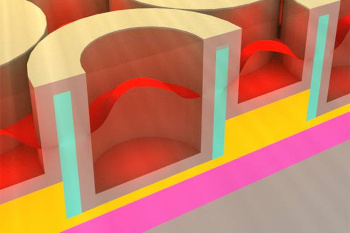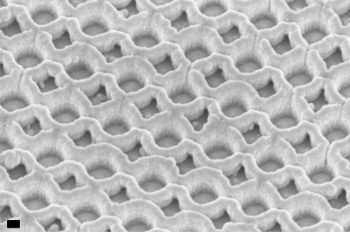Perfect Solar Absorber
October 17, 2014
Photovoltaics are a convenient way to
harvest solar energy, but creating a photovoltaic
solar cell is
tricky business. Not all
incident light will be converted to
electricity. A
photon incident on a
solar panel might pass right through the
material; or, it might be
reflected away. Only at a range of
wavelengths, as determined by the solar cell materials, will the photon create an
electron-hole pair, so that these
charge carriers have a reasonable
probability of reaching terminating
electrodes to create an
electric current.
The
photovoltaic effect was discovered in 1839 by
Edmond Becquerel (1820 - 1891). Edmond was the father of
Henri Becquerel (1852-1908), the discoverer of
radioactivity and recipient of the 1903
Nobel Prize in Physics (see figure). The discovery of
junction semiconductors marked a renewed interest in solar cells, and
Bell Labs demonstrated a junction solar cell in 1951.

Edmond (left) and Henri Becquerel (right). Physics ran in their family; or, to borrow a line from the play, Arsenic and Old Lace, "It practically gallops." They were the middle two of four generations of physicists. Left image, lithograph of Edmond Becquerel by Pierre Petit (1832-1885), and right image, portrait of Henri Becquerel (1852-1908), circa 1905, by Paul Nadar (1856–1939), via Wikimedia Commons)
This early solar cell had an
energy conversion efficiency of light to
electrical power of just two percent. A few years later, in 1954,
Hoffman Electronics Corporation (
El Monte, California) produced solar cells with 4.5% efficiency, eventually attaining 14% in a commercial product by 1960. Hoffman Electronics solar cells powered the
Vanguard 1 satellite, launched in 1958.
Vanguard 1 was the first solar-powered satellite, but the power was minuscule. The solar cells powered a 5
milliwatt transmitter.
Telstar, launched in 1962, had much of its large outer shell covered with solar cells that generated about fourteen watts of electrical power. Compare this with today's solar-powered
direct-broadcast satellites that power more than a kilowatt of transmitter power.
One interesting footnote of Telstar history is that Bell Labs
engineer,
John R. Pierce (1910 - 2002), who was executive
director of the Bell Labs division in which Telstar was built, wrote
science fiction. He used the
pseudonym, "J.J. Coupling."[1]
J-J coupling is a particular electron
spin-orbit coupling of
momentum that should be familiar to most physicists.
The
efficiency of commercially available photovoltaics is now about 25%, but there are
laboratory demonstrations of efficiency at
nearly 50%. As I wrote in a
recent article (Solar Steam, August 15, 2014), photovoltaics aren't the only route to efficient solar energy collection. One team of
engineers has produced a black absorber that's a
porous composite of
graphite flakes and
carbon foam that floats on
water to convert solar energy to
steam.[2-3]
A solar-black absorber will, by definition, absorb energy from the entire
solar spectrum. As a consequence, the absorber will
heat, giving you options as to how this heat can be used. A team of engineers from
MIT's Solid State Solar Thermal Energy Conversion Center of its
Micro and Nano Systems Laboratory and their colleagues has devised a nearly perfect solar absorber. The absorber, a metallic dielectric
photonic crystal layer, is described in a recent paper by MIT postdoc
Jeffrey Chou, MIT professors
Marin Soljacic,
Nicholas Fang,
Evelyn Wang, and
Sang-Gook Kim, along with five others presently at other institutions.[4-6]
Photonic crystals, the
optical analogs of
semiconductor crystals, allow control of light in the same way that semiconductors control electrons. The purpose of the photonic crystal in the solar absorber is to selectively allow absorption of solar energy while suppressing
long wavelength (heat) emission. This allows construction of a solar
energy harvester that operates by conversion of solar energy to
thermal energy.[4-5] The photonic crystal layer has the additional advantages that it absorbs sunlight from a wide range of
angles, it operates at high
temperature, and it can be
manufactured inexpensively.[6]
As in all photonic crystals, the structural dimension must be close to the wavelength of light, so the layer is an array of
nanocavities in which the operating range is selected by the cavity size.[6] The photonic crystal layer is part of a solar-
thermophotovoltaic (STPV) device in which solar energy is converted into heat. The heated material will emit
infrared energy that's subsequently converted to an electrical current.[6] The device was initially built as hollow cavities. Says Jeffrey Chou, the paper's lead
author, “They were empty, there was air inside... No one had tried putting a
dielectric material inside, so we tried that and saw some interesting properties.”[6]

An artistic rendering of an idealized metallic dielectric photonic crystal layer for solar absorption.
(MIT image by Jeffrey Chou.)[6)]
The solar absorber is designed to work at high temperatures in systems with sunlight-concentrating
mirrors. The devices have survived 1000
°C (1832
°F) for 24 hours without severe
degradation.[6] Their solar collecting capability exists over a wide range of angles, so
solar trackers wouldn't be required in some applications.[6] The device can be manufactured with the usual complement of
silicon wafer processing tools. Such silicon wafers range in size up to twelve
inches (300
millimeters) in
diameter.
One stumbling point is the use of
ruthenium, a relatively expensive metal, although substitutions might be possible. That's why the MIT group is investigating other metals. This research was funded by MIT's
Solid State Solar Thermal Energy Conversion Center and the
U.S. Department of Energy,
Office of Science,
Office of Basic Energy Sciences.[4-6]

Scanning electron micrograph of MIT's metallic dielectric photonic crystal solar absorber. This image shows tungsten sputtered onto the alumina shells. The scale bar is 200 nm.
(Fig. S3 of ref. 5, Creative Commons license.)
References:
- Harriett Lyle, "Interview with John R. Pierce," (Pasadena, California, April 16, 23, and 27, 1979), California Institute of Technology Oral History Project.
- Hadi Ghasemi, George Ni, Amy Marie Marconnet, James Loomis, Selcuk Yerci, Nenad Miljkovic, and Gang Chen, "Solar steam generation by heat localization," Nature Communications, vol. 5, article no. 4449 (July 21, 2014), doi:10.1038/ncomms5449.
- Jennifer Chu, "Steam from the sun - New spongelike structure converts solar energy into steam," MIT Press Release, July 21, 2014.
- Jeffrey B. Chou, Yi Xiang Yeng, Yoonkyung E. Lee, Andrej Lenert, Veronika Rinnerbauer, Ivan Celanovic, Marin Soljačić, Nicholas X. Fang, Evelyn N. Wang and Sang-Gook Kim, "Enabling Ideal Selective Solar Absorption with 2D Metallic Dielectric Photonic Crystals," Advanced Materials (Early View, September 16, 2014), doi: 10.1002/adma.201403302.
- Author's final manuscript of ref. 4 (2.0 MB PDF File). Creative Commons Attribution-Noncommercial-Share Alike license.
- David L. Chandler, "How to make a “perfect” solar absorber," MIT Press Release, September 29, 2014.
Permanent Link to this article
Linked Keywords: Photovoltaics; energy harvesting; solar energy; solar cell; theory of solar cells; Snell's law; incident light; electricity; photon; solar panel; material; reflection; reflected; wavelength; carrier generation and recombination; electron-hole pair; charge carrier; probability; electrode; electric current; photovoltaic effect; Edmond Becquerel (1820 - 1891); Henri Becquerel (1852-1908); radioactive decay; radioactivity; Nobel Prize in Physics; junction semiconductor; Bell Labs; physics; play; theater; Arsenic and Old Lace; It practically gallops; generation; physicist; Pierre Petit; Wikimedia Commons; energy conversion efficiency; electric power; electrical power; Les Hoffman; Hoffman Electronics Corporation; El Monte, California; Vanguard 1; satellite; milliwatt; transmitter; Telstar; direct-broadcast satellite; engineer; John R. Pierce (1910 - 2002); director; science fiction; pseudonym; J-J coupling; spin-orbit coupling; momentum; efficiency; laboratory; thin film solar cell efficiency; porosity; porous; composite material; graphite; carbon; foam; water; steam; sunlight; solar spectrum; heat; Massachusetts Institute of Technology; MIT; Solid State Solar Thermal Energy Conversion Center; Micro and Nano Systems Laboratory; photonic crystal; Jeffrey Chou; Marin Soljacic; Nicholas Fang; Evelyn Wang; Sang-Gook Kim; optics; optical; analogy; analog; semiconductor; crystal; long wavelength (heat) emission; energy harvester; temperature; thermal; angle; manufacturing; nanoscopic scale; nanocavity; thermophotovoltaic; infrared energy; author; dielectric; art; artistic; metal; metallic; mirror; celsius; Fahrenheit; chemical decomposition; degradation; solar tracker; silicon wafer; semiconductor device fabrication; inch; millimeter; diameter; ruthenium; United States Department of Energy; Office of Science; Office of Basic Energy Sciences; scanning electron microscope; scanning electron micrograph; tungsten; aluminium oxide; alumina; nanometer; nm.